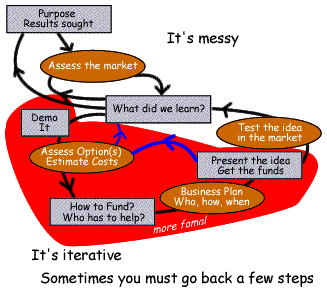|
Process, Meeting Agenda, Timelines
for:
Scenarios
Bottom-up
or
Entreprenuers in Small Firms
Bottom-up
in Large Firms
Classic
Strategic
Planning
"Team-based
Forecasting" |
Bottom-up "entrepreneurs" in a big company
 Inside
a large corporation, very talented folks will be innovative
about the firms purpose, products, and processes — sometimes
against the grain. The spirit and commitment is the same
as the entrepreneur taking an idea to market by mortgaging
her house. Their challenge is to sell a strategy bottom-up. Inside
a large corporation, very talented folks will be innovative
about the firms purpose, products, and processes — sometimes
against the grain. The spirit and commitment is the same
as the entrepreneur taking an idea to market by mortgaging
her house. Their challenge is to sell a strategy bottom-up.
Go to the Methods Chapter to review suggestions on speeding
up innovation.
A bigger team
The team needs a coalition of key players at their level,
above their level and below their lever. More folks are
involved.
Demo it at the right time
It's more likely they will need to demonstrate the concept
(with very limited funds) before they make a formal request
for funding.
I've added one more "formal event" to the
process, sticking to strategy formulation language, demonstrating
the idea(s) to the right people at the right time.
The Coalition and Timing
Every very experienced, successful CEO I've met wants
their folks to be innovative. It is sometimes hard to
be heard.
Who is involved early
Inside a big company, in addition to the core team,
you need to recruit a coalition from your peers, your
customers and the folks who will implement. Two purposes:
to get their advice and to create support when you ask
for money.
This may be formalized into a strategy development steering
group.
Don't lose a silver bullet
The small business entrepreneur plugs ahead until the
idea is accepted.
The entrepreneur in a big company needs to consider
the timing of when to introduce an idea — too soon,
get told no. My experience and other folks who have done
this successfully spent a lot of time thinking about
when and where to first pitch their idea to one or two
senior leaders.
Timelines in a Large Firm
Folks involved
The strategic planning team, usually a coalition of
key players in the firm and sometimes customers, develops
the idea to the point where is can compete for funding
in the firm. As the idea coalesces, the meetings in the
process become more formal.
Timeline

Key Points
- Vision here is the route to take to bring a product
or service to the customer, the customer
benefit is the selling point
- Strategy formulation starts informally
- Form a talented team early
- Assess what do your customers think, all the time,
involve them
- Goals align to grow market share for your products
or services
- In a larger firm, you need to lay some ground work
by demonstrating the idea
- You have to carefully think through where you will
get the start up funds
- Prepare a thorough, persuasive business plan if you
need to ask for money
- You must sell yourself to the folks who will give
you money
- Expect that you need to adapt rapidly as you offer
your product or service to the market
 Small Firms Small Firms |
|
Top Down Strategy - Team Forecasting  |
|